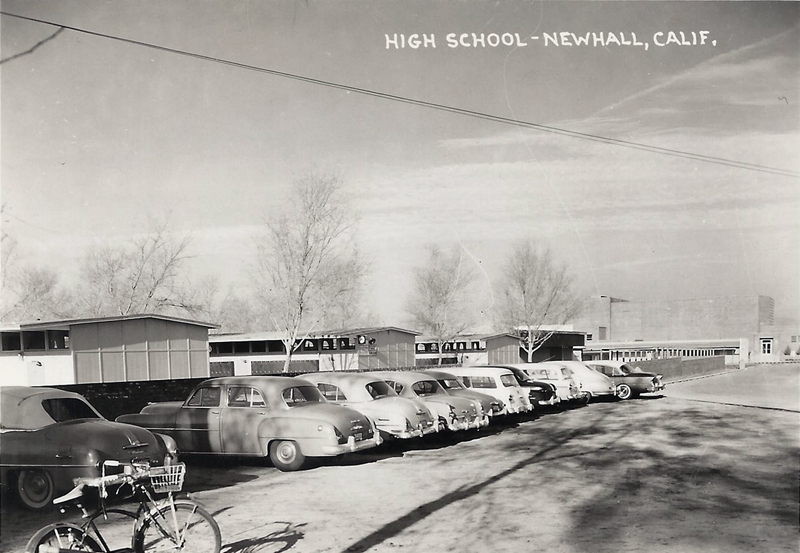|
|
Newhall, California

Click image to enlarge William S. Hart Junior and Senior High School — serving grades 7-12 — was the only one of either in the Santa Clarita Valley when this photograph was shot in the mid-1950s. The view is of the front of the school on Newhall Avenue, looking northwest. The auditorium, which opened Sept. 12, 1952, can be seen at far right. (The front doors of the auditorium are out of frame.) Unused real photo postcard on Kodak paper, purchased in an online auction. On January 13, 1945, the California State Board of Education approved the petitions of five elementary school districts in the Santa Clarita Valley — Newhall, Saugus, Castaic, Mint Canyon and Sulphur Springs — to form the "Santa Clarita Union High School District." Two weeks later, on January 29th, local residents voted 1,184-7 to create Santa Clarita Union High School District. On March 9 they elected its first five-member board, and on June 2 they voted 432-2 to pass a $300,000 bond measure to build the valley's first high school on a 27-acre parcel in Newhall, 20 acres of which had been donated to the new school district. Local historian A.B. Perkins suggested the name "Santa Clarita," or "Little St. Clare," for the new school — a diminutive form of the name given to the valley and to its river by Father Juan Crespí in 1769. However, the school's opening in 1946 came just three months after the death of its chief benefactor, cowboy actor and Newhall resident William S. Hart. And so the school, and the school district, bear Hart's name to this day (although the school board occasionally flirts with the idea of changing the district's name back to "Santa Clarita"). The five original members of the Santa Clarita Union High School District governing board were elected on March 9, 1945. They were: Tom M. Frew, Jr. and S.S. Donaldson, representing the Newhall School District; Mary Bonelli, representing Saugus; Mildred Gilmour, representing Castaic; and Charles Brown, representing Mint Canyon and Sulphur Springs. All were current members of their respective elementary school boards with the exception of Frew, who had retired from the Newhall board after serving as its president for several years.
LP5401: 19200 dpi jpeg from original RPPC purchased 2013 by Lauren Parker. |
"Indians" Nickname 1946
1948 Yearbook
Lester Dalbey 1948
Class of 1949
Gwen & Dean Gallion Collection 1949-50
1949 Yearbook
1949 Graduation
1950
1950 Yearbook
1951 Yearbook
1952 Yearbook; Auditorium Const.
Auditorium Dedication 9/12/1952.
Auditorium 1952
1953 Yearbook
Mid-1950s
1954 Yearbook
1955 Yearbook
Joe Kapp (1955), 2005
1956 Yearbook
1957 Yearbook
1958 Yearbook
1958 Commencement Program
1959 Yearbook
1960 Yearbook
1960 Girl of Year+
1960 Commencement Program
1961 Yearbook
1961 Commencement Program
1961 Lettergirls Banquet
George Harris, C.M. MacDougall, Ronald Reagan at Hart 1960s
1962 Yearbook
1963 Yearbook; Supt. Irvin Shimmin Bio
1964 Yearbook
1965 Yearbook
1966 Yearbook
1967 Yearbook
1968 Yearbook
1969 Yearbook
Class of 1969
Class of 1969: Commencement, 10yr Reunion Programs
Louden Stanford, Newhall's John Muir
|
The site owner makes no assertions as to ownership of any original copyrights to digitized images. However, these images are intended for Personal or Research use only. Any other kind of use, including but not limited to commercial or scholarly publication in any medium or format, public exhibition, or use online or in a web site, may be subject to additional restrictions including but not limited to the copyrights held by parties other than the site owner. USERS ARE SOLELY RESPONSIBLE for determining the existence of such rights and for obtaining any permissions and/or paying associated fees necessary for the proposed use.








































